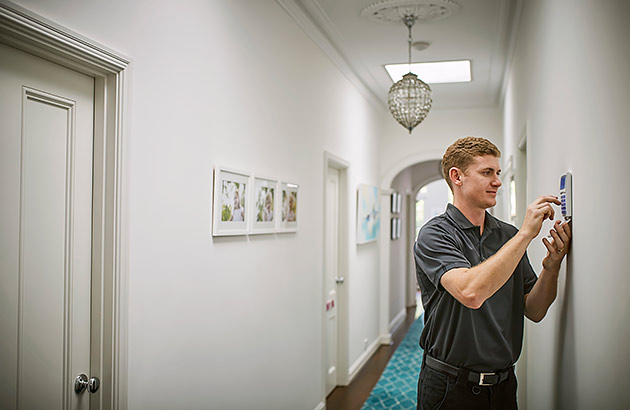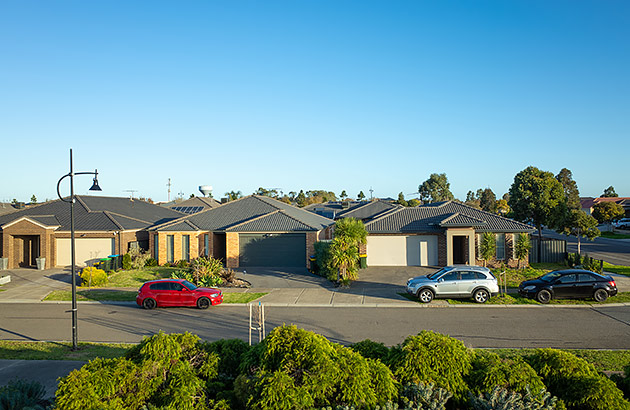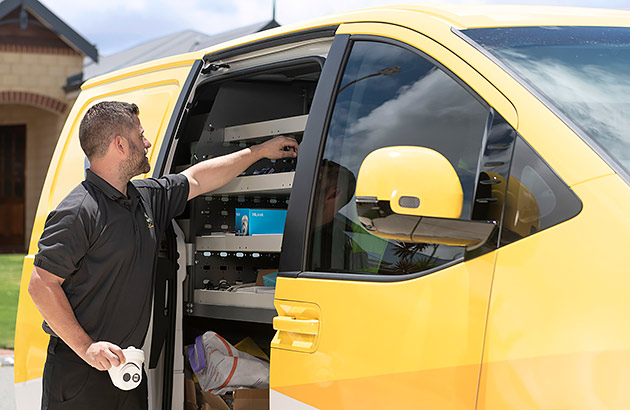By: Vanessa Pogorelic
When deciding on how to best protect your home with a security system, your two key considerations will be your living situation and the layout of your home. You’ll also need to factor in your budget, and the pros and cons of a DIY versus a professionally installed system.
Let’s start with the central component in any home security set-up – the alarm system.
Choosing a home alarm system
The most basic alarm system will detect movements via passive infrared sensors that are placed around your home. When the sensors pick up movement, the system’s alarm will be triggered.
Alarm systems can also incorporate perimeter motion detection. A perimeter alarm detects movement in any windows and external doors in your home using sensors that detect excessive vibration and movement in any of these entry points. So a perimeter alarm can alert you before someone actually does force entry into your property.
Perimeter alarms can be activated while you’re in the home and enable you to move around without tripping the alarm.

For families with small children, having an alarm system that can be split into zones is important if you want to be able to use the alarm overnight when everyone is at home. This will allow you to disable sensors in part of the home to allow occupants to move around within that zone without triggering the alarm.
RAC's home security consultant, Andre Smith, believes perimeter alarms are one of the greatest deterrents for burglars.
“When they get close enough to windows and doors they can see the warning stickers, they can spot devices sitting at the top of doors and frames and know the system will activate before they’ve had a chance to secure the entry point so they’re likely to move on to an easier target.”
If you have a pet that may move around the house at night or will be in the house at times when you’re not there, consider an alarm that includes a pet senor.
Security alarms can include pet immune motion sensors that can differentiate between humans and animals. How this works depends on the type of sensor installed. Pet Immune Passive Infrared Motion sensors are less sensitive to movement lower to the ground so your dog or cat can literally go under the radar.

They need to be positioned accurately to work best. Pet Immune Dual Technology Motion sensors are more complex and use two different detection sensors. The unit is more tolerant of alarms being triggered due to animals, even larger animals or small animals in a group, as both sensors need to be active for the alarm to trigger.
Another option to consider as part of your alarm system is a panic button. These can be installed in various areas of the home to be used emergencies. Panic buttons can provide peace of mind for the elderly and those living with a disability or medical condition.
RELATED:
What makes a home more burglary prone? »
Whichever alarm you choose, the design of the system used in your home will vary depending on whether it is a single or multiple storey home, how many entrances it has, and which specific areas sensors will be installed in to provide maximum security coverage.
Wired vs. wireless home alarm systems
Home alarms can either be wireless or hardwired depending on the construction of your home, explains Andre.
“On a double-storey homes, if we’re coming in post-construction, the installs tend to be wireless. Some older homes tend to be wireless also.
“With wireless though, you have the additional maintenance of having to replace the batteries every few years.”
In a system which is completely wireless, both the controller and all the sensors are wireless, meaning the system is run fully on battery power.
A system that is connected to your home’s power supply, or hardwired, will generally have the main controller connected to your home power supply but the sensors maybe be wireless, although in some older systems, the sensors are also hardwired.

The two great advantages of fully wireless alarm systems are their portability and cost. As the system is not hardwired, you can take it with you when you move to a new home.
A wireless system may be good for renters who want to take the system with them to their next property.
A disadvantage of wireless systems is that they are a prone to internet outages and interference from other radio frequencies. Because they rely on battery power, they can experience outages when the batteries run out of charge. They may also have limited range, so depending on the layout of your home, a wireless system may not be the right choice.
Some cheaper wireless systems may only require DIY installation. Ideally a home alarm system should be installed by a professional and licensed installer. Buying your alarm from a reputable security company will ensure it is installed correctly, has a wireless solution that overcomes the radio frequency interference and power outages, and that the system complies with the correct Australian Standard.
“We find with the DIY stuff we replace a lot of it. Because they’re not mains powered systems, they’re designed to look for movement and send a notification. But depending on the environment, they could be pinging your phone all day. So rather than having a month of battery life, people find they have to take them down regularly to charge them up again. But the bigger concern is that they require wireless internet to work without disruption.”
Monitored vs. self-monitored alarms
In addition to setting off an alarm, many modern alarms system will send an alert to your mobile phone via an app so you’re aware that the system has been triggered.
If your alarm is self-monitored, meaning it is not connected to an external monitoring service, when you do receive an alert that the alarm has been triggered, it is then up to you to determine how to respond, depending on whether you’re in or away from the home at the time.
Your other option to is to engage a security service to monitor your alarm. A simple hardware addition for wired units can give your existing alarm this capability. Some wireless alarms already include the hardware to connect to the monitoring station. With a monitoring subscription you can then engage a professional security service to provide 24-hour monitoring of your alarm.

If activity is detected, they will either call our or send an alert to your phone. If you don’t respond the service will follow your pre-arranged instructions which can include sending a security guard to your property who can, if necessary, contact police or any other emergency services required. Professional alarm monitoring is an additional ongoing cost so may not be an option if your budget it tight.
Choosing CCTV cameras
As the cost of Closed Circuit Television (CCTV) cameras has continued to come down, more households have been adding them as an extra defence to their home security system.
CCTV cameras enable you to monitor your home from wherever you are and the presence of cameras outside your home can also work to deter intruders.
Being able to produce clear video footage of an intruder entering your home can increase the likelihood of them being found and charged.
Monitoring your home with CCTV cameras can help close any gaps in your home security plan, making them incredibly valuable security tools.

But RAC’s Andre Smith warns they shouldn’t be considered as a standalone security solution
“We get a lot of the enquiries for camera solutions because it’s the first thing that comes to mind for many people. They think it’s a great way to keep people off their property.
“But if the objective is to keep someone out of the house, I’d always recommend an alarm.”
To be of real value to you when they’re needed, there are several features you should look for when considering a CCTV camera or multi-camera CCTV system.
The quality of the image is paramount. Make sure the camera produces high-resolution images by checking the megapixel (MP) capacity of the camera. The higher the pixel count, the better the image resolution and zoom-in ability. A camera with a resolution of 6MP should give you a clear image and good low-light performance. Infra-red illuminated cameras can also provide up to 10m of illumination in low- or no‑light conditions.
There should be enough memory to store large amounts of recorded footage. Having a wide angle of view is also important, as is the installation of position of any cameras to ensure you have good coverage around your property.
Once installed, your CCTV system can be accessed via a smartphone, tablet or home computer, allowing you to remotely monitor your home, check if the system has detected a disturbance, and contact police if needed. It can also be connected to your existing home alarm system.
How secure is your home?
Is your home an open book for opportunistic burglars? Check out our security checklist to find out how secure you home is and get suggestions for how to improve it.
*RAC's security services operates in Perth Metro and Mandurah only.
